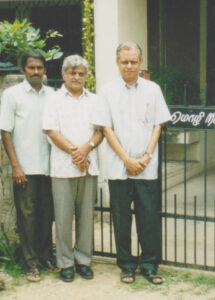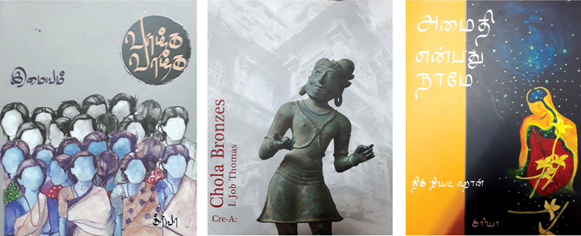Registered with the Registrar of Newspapers for India under R.N.I 53640/91
Vol. XXX No. No. 16, December 16-31, 2020
The story of a Wordsmith
by S. Theodore Baskaran

Ramakrishnan (second from left) at Mozhi.
In the early seventies, writer S.V. Rajadurai introduced me to a group of young men, passionate about literature. One among them was S. Ramakrishan. They met in poet Gnanakoothan’s room in Triplicane and ideas for articles, magazines and books came out of the discussions. Here was born Ka Sa Da Tha Pa Ra, (க ச ட த ப ற) a Tamil literary magazine which carried articles by chosen writers. The logo of this periodical was a dagger-wielding puppet, a line-drawing by Adhimoolam, marking the beginning of interaction between modern art and the Tamil literary world. Later, artistes like Achuthan Kudalur, R.B. Baskaran and Jayaraman would do cover drawings for the books published by Ramakrishnan. He persuaded me to write in the magazine, my first Tamil article சிவதாண்டவம் (Shivatandavam) on the film The Dance of Siva, directed by Chidhananda Das Gupta on the work of Ananda Kumarasamy
Deeply concerned about the quality of content and form of books in Tamil, Ramakrishnan, in 1979, founded a publishing outfit, Cre-A, and began a steady stream of publications, poetry, fiction and non-fiction. I was one of the three signatories for the registration of Cre-A. In the initial months Ram was the sole functionary. Later he was joined by writer Dilipkumar. The Cre-a office at 268, Royapettah High Road was a book shop, an office, a rendezvous point and for sometime an art gallery. The list of writers he published reads like a who-is-who of Tamil literature – Ambai, Sundara Ramasamy, S.V. Rajadurai, Sa Kandasamy, Imayam, Dilipkumar, Asokamithran, G. Nagarajan, Poomani and Na Muthuswamy. Cre-A introduced new subjects to Tamil readers like Existentialism, through a book on the subject by S.V. Rajadurai.

Cover of Imayam’s novel Vazhga…Vazhga, Chola bronzes and Tamil verson of Zen Master Thich Nhat Hanh’s Being Peace.
He brought in the concept of editing to the Tamil realm at a time when most writers had no idea about it or looked upon it as an intrusion on their preserve. Ram was a meticulous editor and would go deep into words, sentences and ideas. A friend called him a ‘screw driver’ for his style of functioning as an editor. Every single book brought out by Cre-A was painstakingly edited by him. When Imayam thanked Ram for the editing his novel கோவேறு கழுதைகள் he replied “You gave an uncut diamond and I merely polished it. Had it been charcoal I could not have done anything.” I experienced it myself when he published my book The Message Bearers in1981. He came over to Coimbatore where I was living and we worked for three days. The book marked a turning point in my life.
He had an acute insight into words. Mark Tully who devotes two pages to Ram in his book No Full Stops to India calls to him a ‘wordsmith’. It was his involvement with words that motivated him to produce the Dictionary of Contemporary Tamil.
Along with some writers and artistes, Ramakrishnan attended a Film appreciation workshop in Chennai in 1977 conducted by the Pune Film Institute and this opened his eyes for cinema. He got to know Prof. Satish Bahadur and kept up his interest in cinema. Cre-A brought out a book written by V. Sriram on four French new-wave directors – Robert Bresson, Louise Malle, Francois Truffaut, and Eric Rohmer.
Ram’s interest spanned wildlife also. A book on spiders, with colour plates was his first venture in this field. He brought out a fine field guide in Tamil for birdwatchers. Soon similar guides to butterflies and dragon flies followed. A Tamil version of Zen master Thich Nhat Hanh’s iconic work Being Peace was brought out last year.
In translation he set standards. Be it Franz Kafka (விசாரணை) or Camus (அந்நியன்) the translation was from the original and done after due formalities from the copyright owners. I remember the correspondence he had with Camus’ wife when he wanted to publish The Stranger. It was before the arrival of email. He was concerned about the poor state of translations in Tamil and was planning workshops for translation, along with A.K. Ramanujam, when the latter died during a surgery.
As new concerns develop , the language of a society has to be equipped to handle such concerns. This idea gave birth to an outfit Ramakrishnan founded in 1989 called Mozhi, which means language. Mozhi has published works related to Tamil language, including a manual for Writers. Mozhi had a project to produce a spellcheck in Tamil but had to be given up halfway It was at this period, in 1994 to be precise that along with Sankaralingam, he was involved in the ground work for setting up Roja Muthiah Research Libarary. I worked as secretary of Mozhi for two years and was able to learn a lot and got to know scholars such as Iravatham Mahadevan and Numan Mohmad.
The books that Ramakrishnan published, almost like hand-crafting, have influenced Tamil publishing and have had a cascading effect, in production values.

